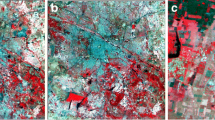Abstract
Urban areas are the most dynamic region on earth. Their size has been constantly increased during the past and this process will go on in the future. Since there is no standard policy and guidelines for construction of buildings and urban planning, cities tend to have irregular growth. Many cities in the world face the problem of urban sprawl in its suburbs. So issues of urban sprawl need to be settled with the help of technologies such as satellite remote sensing and automated change detection. This paper presents a wavelet based post classification change detection technique that is applied to 1996 and 2004 MSS images of Madurai City, South India to determine the urban growth. The classification stage of the technique uses coilflet wavelet filter to correlate with the MSS land cover images of Madurai city to derive texture feature vector and this feature vector is inputted to a fuzzy-c means classifier, an unsupervised classification procedure. The post classification change detection technique is employed for identifying the newly developed urban fringe of the study area. The error matrix analysis is used to assess the accuracy of the change map. The performance of the presented technique is found superior than that of classical change detection methods such as image differencing, change vector analysis and principal component analysis.






Similar content being viewed by others
References
Acharyya, M., & Kundu, M. K. (2007). Image segmentation using wavelet packet frames and Neuro-fuzzy tools. International Journal of Computational Cognition, 5(27–43).
Arivazhagan, S., & Ganesan, L. (2003). Texture classification using wavelet transform. Pattern Recognition Letters, 24, 1513–1521.
Chan, J. C., Defries, R. S., Zhan, X., Haung, C., & Townshed, J. R. G. (2000). Texture features for land cover change detection at 250 m resolution- An application of machine learning feature subset selection. IEEE Geoscience and Remote sensing symposium, 7, 3060–3062.
Chanussot, J., Benediktsson, J. A., & Fauvel, M. (2006). Classification of remote sensing images from urban areas using a fuzzy possibilistic model. IEEE Geoscience and remote sensing letter, 3(1), 2006.
Coggins, J. M., & Jain, A. K. (1985). A spatial filtering approach to texture analysis. Pattern Recognition Letters, 3(3), 195–203.
Collins, J. B., & Woodcock, C. E. (1996). An assessment of several linear change detection techniques for mapping forest mortality using multitemporal Landsat TM data. Remote Sensing of Environment, 56, 66–77.
Fung, Tung. (1990). An assessment of TM imagery for land – cover change detection. IEEE Transactions on Geoscience and Remote Sensing, 28(4).
Johnson, R. D., & kasischke, E. S. (1998). Change vector analysis: A technique for the multispectral monitoring of landcover and condition. International Journal of Remote Sensing, 19, 411–426.
Kressler, F. P., & Steinnocher, K. T. (1999). Detecting land cover changes from NOAA AVHRR data by using spectral mixture analysis. International Journal of Applied Earth Observation and Geoinformation, 1, 21–26.
Lambin, E. F., & Strahler, A. H. (1994). Change vectoranalysis in multitemporal space: Atool to detect and categorise land cover change processes using high temporal resolution satellite data. Remote Sensing of Environment, 48, 231–244.
Laws, K. I. (1980). Rapid texture identification. Proc. SPIE Conf. Image Processing for Missile Guidance, pp. 376–380.
Lindsay, R. W., Percival, D. B., & Rothrock, D. A. (1996). The discrete wavelet transform and the scale analysis of the surface properties of sea ice. IEEE Transactions on Geoscience and Remote Sensing, 34, 771–787.
Mallat, S. G. (1989). A theory for multiresolution signal decomposition: The wavelet representation. IEEE Transactions Pattern Analysis and Machine Intelligence, 11, 674–693.
Mas, J. K. (1999). Monitoring land-cover changes: a comparision of change detection techniques. International Journal of Remote Sensing, 20(1), 139–152.
Melgani, F., Moser, G., & Serpico, S. B. (2002). Unsupervised change detection methods for remote sensing images. Optical Engineering, 41(3288–3297).
Mrril, K. R., & Jiajun, L. (1998). A comparision of four algorithms for change detection in an urban environment. Remote Sensing of Environment, 63, 95–100.
Muller, S. V., Walker, D. A., Nelson, F. E., Auerbach, N. A., Bockheim, J. G., Guyer, S., & Sherba, D. (1998). Accuracy assessment of land cover map of the kupaaruk river basin, Alaska: Consideration for remote regions. Photogrammetric Engineering and Remote Sensing, 64(6), 1998.
Niedermeier, A., Romaneesen, E., & Lehner, S. (2000). Detection of coastline SAR images using wavelet methods. IEEE Transactions on Geoscience and Remote Sensing, 38, 2270–2281.
Richards, J. A. (1993). Remote sensing digital image analysis. New York: Springer Heidelberg.
Singh, A. (1989). Digital change detection techniques using remotely sensed data. International Journal of Remote Sensing, 10, 989–1003.
Acknowledgements
The authors are thankful to the Indian Space Research Organization(ISRO)- Bangalore, Department of Space, Government of India for providing financial assistance under RESPOND Scheme to carry out the research (Sanction Letter 10/4/506 dt. March 2005).
Author information
Authors and Affiliations
Corresponding author
About this article
Cite this article
Raja, R.A.A., Anand, V., Kumar, A.S. et al. Wavelet Based Post Classification Change Detection Technique for Urban Growth Monitoring. J Indian Soc Remote Sens 41, 35–43 (2013). https://doi.org/10.1007/s12524-011-0199-7
Received:
Accepted:
Published:
Issue Date:
DOI: https://doi.org/10.1007/s12524-011-0199-7




